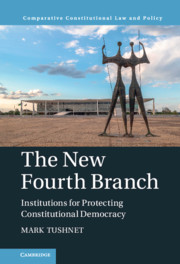Book contents
- The New Fourth Branch
- Comparative Constitutional Law and Policy
- The New Fourth Branch
- Copyright page
- Contents
- Acknowledgments
- 1 Introduction
- 2 Why a Fourth Branch?
- 3 Why a Fourth Branch?
- 4 Design Issues in General
- 5 Design Principles in Practice
- 6 Anti-corruption Investigations
- 7 Electoral Commissions
- 8 Audit Agencies
- 9 Conclusion
- Index
6 - Anti-corruption Investigations
Case Studies from Brazil and South Africa
Published online by Cambridge University Press: 20 August 2021
- The New Fourth Branch
- Comparative Constitutional Law and Policy
- The New Fourth Branch
- Copyright page
- Contents
- Acknowledgments
- 1 Introduction
- 2 Why a Fourth Branch?
- 3 Why a Fourth Branch?
- 4 Design Issues in General
- 5 Design Principles in Practice
- 6 Anti-corruption Investigations
- 7 Electoral Commissions
- 8 Audit Agencies
- 9 Conclusion
- Index
Summary
During the late twentieth century, first policy-makers, then students of constitutionalism, came to understand that pervasive corruption undermines constitutional democracy.1 Corruption at the street level – police officers who respond to complaints and civil servants who process claims only after receiving bribes – undermines citizen confidence that their government can deliver anything worthwhile.2 Corruption at the highest levels, this chapter’s focus, breaks the connection between elections and policy outcomes. By the late twentieth century, the project of fighting corruption had become an important component in democracy promotion and, by extension, in constitutional design.
- Type
- Chapter
- Information
- The New Fourth BranchInstitutions for Protecting Constitutional Democracy, pp. 97 - 122Publisher: Cambridge University PressPrint publication year: 2021

